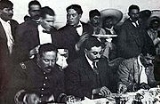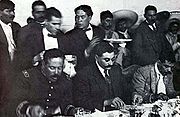
Convention of Aguascalientes
Encyclopedia
The Convention of Aguascalientes was a major meeting that took place during the Mexican Revolution
.
The call for the Convention was issued on 1 October 1914 by Venustiano Carranza
, head of the Constitutional Army
, who described it as the Gran Convención de Jefes militares con mando de fuerzas y gobernadores de los Estados ("Great Convention of Commanding Military Chiefs and State Governors").
Its first sessions were held in the Chamber of Deputies in Mexico City
, but were later transferred to the city of Aguascalientes
, whence its name, where it met from 10 October to 9 November 1914.
, who had usurped the presidency
in a coup d'état in February 1913, resigned the office in July 1914 on account of Revolutionary pressures and left the country.
He was replaced by Venustiano Carranza
, who wished to discuss his government's policies with the other revolutionary leaders, and so called for the Convention to take place. But, faced with the absence of the Zapatistas (who did not recognise Carranza's authority) and the refusal of Francisco Villa to attend a meeting in Mexico City, it was agreed to relocate the Convention to Aguascalientes, Ags.
 The convention was intended to little the differences between the "big four" warlords who played the biggest roles in overthrowing Huerta: Pancho Villa
The convention was intended to little the differences between the "big four" warlords who played the biggest roles in overthrowing Huerta: Pancho Villa
, Emiliano Zapata
, Venustiano Carranza
and Alvaro Obregon
. From the onset, however, the Convention was dominated by the Villistas, who imposed their points of view on the other delegates.
The supporters of Emiliano Zapata
did not arrive until 26 October (a delegation of 26, led by Paulino Martínez and Antonio Díaz Soto y Gama
). The Convention declared itself sovereign
, elected General Eulalio Gutiérrez Ortiz as President of Republic, and appointed Villa commander of the Conventionalist Army, which then took up arms against Carranza's Constitutionalists. Due to the disagreements that Carrazana had with Zapata and Villa, the three refused to attend the convention and little developed as a result.
After the meeting, the newly reconciled Villa and Zapata entered Mexico City on 6 December, at the head of an army of 60,000 men. Carranza and his supporters consequently fled to Veracruz
.
Mexican Revolution
The Mexican Revolution was a major armed struggle that started in 1910, with an uprising led by Francisco I. Madero against longtime autocrat Porfirio Díaz. The Revolution was characterized by several socialist, liberal, anarchist, populist, and agrarianist movements. Over time the Revolution...
.
The call for the Convention was issued on 1 October 1914 by Venustiano Carranza
Venustiano Carranza
Venustiano Carranza de la Garza, was one of the leaders of the Mexican Revolution. He ultimately became President of Mexico following the overthrow of the dictatorial Huerta regime in the summer of 1914 and during his administration the current constitution of Mexico was drafted...
, head of the Constitutional Army
Constitutional Army
The Constitutional Army was the army that fought against Huerta's Federal Army, and later, against the Villistas and Zapatistas during the Mexican Revolution. It was formed in March 1913 by Venustiano Carranza, so-called "First-Chief" of the army, as a response to the murder of President Francisco I...
, who described it as the Gran Convención de Jefes militares con mando de fuerzas y gobernadores de los Estados ("Great Convention of Commanding Military Chiefs and State Governors").
Its first sessions were held in the Chamber of Deputies in Mexico City
Mexico City
Mexico City is the Federal District , capital of Mexico and seat of the federal powers of the Mexican Union. It is a federal entity within Mexico which is not part of any one of the 31 Mexican states but belongs to the federation as a whole...
, but were later transferred to the city of Aguascalientes
Aguascalientes, Aguascalientes
The city of Aguascalientes is the capital of the state of Aguascalientes in western central Mexico. It stands on the banks of the Río Aguascalientes, 1880 meters above sea level, at...
, whence its name, where it met from 10 October to 9 November 1914.
Background
General Victoriano HuertaVictoriano Huerta
José Victoriano Huerta Márquez was a Mexican military officer and president of Mexico. Huerta's supporters were known as Huertistas during the Mexican Revolution...
, who had usurped the presidency
President of Mexico
The President of the United Mexican States is the head of state and government of Mexico. Under the Constitution, the president is also the Supreme Commander of the Mexican armed forces...
in a coup d'état in February 1913, resigned the office in July 1914 on account of Revolutionary pressures and left the country.
He was replaced by Venustiano Carranza
Venustiano Carranza
Venustiano Carranza de la Garza, was one of the leaders of the Mexican Revolution. He ultimately became President of Mexico following the overthrow of the dictatorial Huerta regime in the summer of 1914 and during his administration the current constitution of Mexico was drafted...
, who wished to discuss his government's policies with the other revolutionary leaders, and so called for the Convention to take place. But, faced with the absence of the Zapatistas (who did not recognise Carranza's authority) and the refusal of Francisco Villa to attend a meeting in Mexico City, it was agreed to relocate the Convention to Aguascalientes, Ags.
Aguascalientes, Aguascalientes
The city of Aguascalientes is the capital of the state of Aguascalientes in western central Mexico. It stands on the banks of the Río Aguascalientes, 1880 meters above sea level, at...
Convention

Pancho Villa
José Doroteo Arango Arámbula – better known by his pseudonym Francisco Villa or its hypocorism Pancho Villa – was one of the most prominent Mexican Revolutionary generals....
, Emiliano Zapata
Emiliano Zapata
Emiliano Zapata Salazar was a leading figure in the Mexican Revolution, which broke out in 1910, and which was initially directed against the president Porfirio Díaz. He formed and commanded an important revolutionary force, the Liberation Army of the South, during the Mexican Revolution...
, Venustiano Carranza
Venustiano Carranza
Venustiano Carranza de la Garza, was one of the leaders of the Mexican Revolution. He ultimately became President of Mexico following the overthrow of the dictatorial Huerta regime in the summer of 1914 and during his administration the current constitution of Mexico was drafted...
and Alvaro Obregon
Álvaro Obregón
General Álvaro Obregón Salido was the President of Mexico from 1920 to 1924. He was assassinated in 1928, shortly after winning election to another presidential term....
. From the onset, however, the Convention was dominated by the Villistas, who imposed their points of view on the other delegates.
The supporters of Emiliano Zapata
Emiliano Zapata
Emiliano Zapata Salazar was a leading figure in the Mexican Revolution, which broke out in 1910, and which was initially directed against the president Porfirio Díaz. He formed and commanded an important revolutionary force, the Liberation Army of the South, during the Mexican Revolution...
did not arrive until 26 October (a delegation of 26, led by Paulino Martínez and Antonio Díaz Soto y Gama
Antonio Díaz Soto y Gama
Antonio Diaz Soto y Gama was a revolutionary during the Mexican Revolution and Mexican politician.His parents were Conrad Diaz Soto y Gama and Dona Concepcion Cruz...
). The Convention declared itself sovereign
Sovereignty
Sovereignty is the quality of having supreme, independent authority over a geographic area, such as a territory. It can be found in a power to rule and make law that rests on a political fact for which no purely legal explanation can be provided...
, elected General Eulalio Gutiérrez Ortiz as President of Republic, and appointed Villa commander of the Conventionalist Army, which then took up arms against Carranza's Constitutionalists. Due to the disagreements that Carrazana had with Zapata and Villa, the three refused to attend the convention and little developed as a result.
After the meeting, the newly reconciled Villa and Zapata entered Mexico City on 6 December, at the head of an army of 60,000 men. Carranza and his supporters consequently fled to Veracruz
Veracruz, Veracruz
Veracruz, officially known as Heroica Veracruz, is a major port city and municipality on the Gulf of Mexico in the Mexican state of Veracruz. The city is located in the central part of the state. It is located along Federal Highway 140 from the state capital Xalapa, and is the state's most...
.

